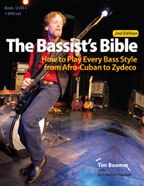 (From The Bassist’s Bible: How to Play Every Bass Style from Afro-Cuban to Zydeco [second edition], by Tim Boomer, a style guide for bass players, divided into chapters by style; every chapter begins with a brief overview of the style’s history and development. This is a revised version of the brief history of Country that appeared in The Drummer’s Bible, by Mick Berry and Jason Gianni. )
(From The Bassist’s Bible: How to Play Every Bass Style from Afro-Cuban to Zydeco [second edition], by Tim Boomer, a style guide for bass players, divided into chapters by style; every chapter begins with a brief overview of the style’s history and development. This is a revised version of the brief history of Country that appeared in The Drummer’s Bible, by Mick Berry and Jason Gianni. )
Country music is popular around the world and serves an age-old function: storytelling. Its themes of love, heartache, and the promise of salvation in the afterlife are exceedingly popular. It stems from the Appalachian region, where during the 18th and 19th centuries most people were of Scotch or Irish descent. These physically isolated mountaineers performed the Scotch-Irish folk songs of their ancestors. The folk-based formula consisted of ABAB rhyming quatrains citing personal experiences combined with the vocal/harmonic characteristics and subject matter of religious hymns.
Appalachian/Scotch-Irish music centered on the fiddle, and this remained so even after the intrusion of railroads in the 19th century brought new musical influences and instruments to the region. Traveling minstrel shows imported the banjo, providing a unique sound to accompany the fiddle. By the early 1900s, now-affordable, mass-produced guitars gave singers a broader chordal and rhythmic base than the less harmonically versatile banjo and fiddle. This pairing of vocals with guitar accompaniment became the foundation of contemporary Country music.
In the 1920s, radio broadcasts, most notably Nashville’s “The Grand Ole Opry” (first broadcast in 1925), brought Country music to a mass audience. Recognizing its commercial potential, recording pioneer Ralph Peer announced auditions in 1927 in the Bristol, Tennessee newspaper. The indigenous musicians straddling the Virginia-Tennessee border showed up in droves. They included Jimmie Rodgers and The Carter Family. Bluegrass pioneer Bill Monroe replaced the jug player for his Bluegrass Boys with upright bassist Amost Garret in 1939. After Garret, Monroe hired “Cousin” Wilbur Westbrooks in 1940, and in 1944 Howard “Cedric Rainwater” Watts, who appears on all the major Monroe recordings featuring Lester Flatt, Earl Scruggs, and Chubby Wise. In 1948, Watts left Bill Monroe to join Flatt and Scruggs. Watts also played with The Drifting Cowboys backing up Hank Williams Sr., Ray Price, and, decades later, a reformation of The Drifting Cowboys in support of Hank Williams Jr.
In the 1930s, Texas musicians (most notably Bob Wills, with brother Billy Jack Wills on bass) combined the vocal harmonies of Country with the swing feel and improvisation of big band Jazz, while using more complicated harmonies than those of traditional Country music, creating Western Swing. As the name implies, the primary feel was swung, as opposed to the straight feel of most other forms of Country music. Not surprisingly, the upright bass proved indispensable, along with its counterpart, the drum set. Western Swing’s rhythmic base consisted of a swung drum pattern and a walking bass line. However, the drum/bass instrumentation of Western Swing was not wholly accepted within the confines of Country, as evidenced in Bob Wills’ appearance on the stage of “The Grand Ole Opry” on December 30, 1944. Although the Opry lifted its ban on drums for that performance, it immediately reinstated it afterwards.
At about the same time, another relative of Country music appeared in the West, as Roy Rogers and Gene Autry pioneered Western music. Western music differed considerably from both Appalachian hillbilly (Country) music and Western Swing in that it downplayed instrumental virtuosity, was very vocally oriented, and more especially crooner oriented. The subject matter of Western songs also differed greatly from that of Country music. Instead of Country’s strange duality of gritty and religious songs, Western artists sang pop songs (e.g., Gene Autry’s 1941 version of “You Are My Sunshine”), while their original Western songs portrayed a heavily romanticized American West (e.g., “Cool Water” and “Tumbling Tumble Weeds,” both written by bassist Bob Nolan). Western music’s greatest star in the latter half of the 20th century was Marty Robbins (“El Paso”), who used bassists Hillous Butrum and Colin Cameron. The Sons of the Pioneers (founded by Roy Rogers) are Western music’s most durable group, still active even today. The group’s bassists have included Bob Nolan and Pat Brady. Western groups often avoid use of the bass entirely, with bass lines usually played instead on the acoustic guitar. When the bass is used in Western groups, it’s invariably acoustic.
By the 1940s, Country music had made its way into the night life of cities and their run down bars. In the latter part of that decade, Country music’s first post-war superstar, Hank Williams, developed the Honky Tonk style with his backup band the Drifting Cowboys. The band featured bassists Herbert “Lum” York and Howard Watts, and for a time, due to the typically rough venues in which they played, bodyguard “Cannonball” Nichols. The Honky Tonk style inspired what has become the standard Country instrumental line-up: acoustic guitar, electric guitar, electric bass, drums, vocalist, and often pedal steel guitar and/or fiddle, and occasionally piano.
In the 1950s, Ray Price, with his drummer Buddy Harman, developed the Country Shuffle, and the heavier backbeat influence of Rock n’ Roll emerged in Rockabilly. This hybrid Country-Rock style was popularized by Country artists such as Carl Perkins and Johnny Cash, as well as Rock and Rollers such as Jerry Lee Lewis and, of course, Elvis Presley. Of all the early Country bass players, perhaps the most prominent was Bob Moore. He not only recorded with Ray Price, Chet Atkins, Elvis Presley, Jerry Lee Lewis, and Johnny Cash, but he played on over 17,000 recordings with a staggering diversity of artists, including Ernest Tubb, Loretta Lynn, Flatt and Scruggs, Burl Ives, Simon & Garfunkel, Bob Dylan, and Pete Fountain.
Country went “pop” in the late 1950s with the Nashville Sound (which dominated Country for decades). This was essentially an attempt to reach a mass audience by taking the “twang” out of Country. The distinguishing features of the Nashville Sound are a very smooth, heavily produced sound, background strings, vocal choirs, and electric, rather than acoustic, bass. Early examples of this sound are the recordings of Chet Atkins and the more over-produced songs (by influential producer Owen Bradley) of Patsy Cline, in which Bob Moore played on songs such as “Crazy” (written by Willie Nelson), “I Fall to Pieces,” and “Walkin’ After Midnight.”
As a reaction against the pop Nashville Sound, the Country Shuffle-influenced Bakersfield Sound arose in the early 1960s. Its primary exponent was Buck Owens, who wrote and sang “Tiger by the Tail” and “Act Naturally.” Buck’s first bass player was Merle Haggard, who is credited with naming Buck’s backup group “The Buckaroos.” Buck’s later bassists included Doyle Holly and Doyle Curtzinger. The distinguishing feature of the Bakersfield Sound was that the “twang” returned—with the exclusion of strings and vocal choirs. In contrast to earlier Hank Williams-style Country, there was more emphasis on the electric guitar (with a tone owing much to Surf music), and song styles included Western Swing and Country Shuffle. Today, the primary exponent of the Bakersfield Sound is Dwight Yoakam.
The Outlaw Movement of the 1970s was a further reaction against the Nashville Sound. Outlaw music used both Hank Williams-style Country and the Bakersfield Sound, differing from them primarily in its lyrical content, which dwelt on the dark side, emphasizing heavy drinking, barroom brawls, and infidelity. David Allan Coe (“Now I Lay Me Down to Cheat”) was one of the Outlaw standouts. Others included Merle Haggard, Waylon Jennings (who had played bass for Buddy Holly in 1959), and Willie Nelson (who had played bass for Ray Price in the early 1960s). Nelson’s and Jenning’s influential 1976 album, “Wanted: The Outlaws,” featured up-and-coming Nashville bassist Gary Tallent, who went on to record with such notables as Emmylou Harris and Solomon Burke, and who became the primary bassist for Bruce Springsteen.
Another notable trend in the early 1970s was the emergence of Country Rock. On the Rock side, performers included The Byrds, Gram Parsons, The Flying Burrito Brothers, Marshall Tucker, and, most prominently, The Eagles. On the Country side, the musicians included Willie Nelson, Waylon Jennings, and Hank Williams, Jr.
In the 1980s, still another reaction against the Nashville Sound arose with the New Traditional-ists, led by Dwight Yoakam and Steve Earle. These artists returned to the stripped-down sounds of early Country, the Bakersfield Sound, and, to a limited extent, Bluegrass.
Alt-Country rose in the 1990s as yet another reaction to the Nashville Sound. It’s musically ill defined and embraces elements of many styles, including traditional Country, Folk, Rock, Western Swing, Rockabilly, Bluegrass, and even Mariachi. Its lyrics are what set it apart. They avoid Country cliches, are often humorous, often dark, and occasionally overtly leftist (in stark contrast to mainstream Country). Alt-Country’s best-known performers (not that all of them would accept the label) include Steve Earle, Junior Brown, the Austin Lounge Lizards, Calexico, Roger Clyne, Al Perry and the Cattle, The Mavericks, Jim White, James McMurtry, John Hiatt, and Hank Williams III.
But Country Rock is the dominant Country style today, with its performers including Garth Brooks, Clint Black, Shania Twain, Tim McGraw, Toby Keith, Alan Jackson, and Kenny Chesney. The distinguishing features of Country Rock are its use of Country harmonies and melodies, Rock and Country instruments, and Rock drumming and bass grooves. Although it appears deceptively easy, Country music boasts some of the best musicians ever to pick up an instrument, bass included.
Like this:
Like Loading...





